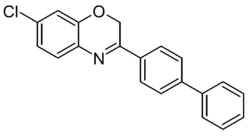Chemistry:QX39
From HandWiki
Short description: Chemical compound
 | |
| Identifiers | |
|---|---|
| |
| CAS Number | |
| PubChem CID | |
| Chemical and physical data | |
| Formula | C20H14ClNO |
| Molar mass | 319.79 g·mol−1 |
| 3D model (JSmol) | |
| |
| |
QX39 (Compound A, CA39) is a synthetic compound that activates chaperone-mediated autophagy (CMA) by increasing the expression of the lysosomal receptor for this pathway, LAMP2A lysosomes. It showed potent activity in vitro but has poor pharmacokinetic properties and was not suitable for animal research. Subsequent research led to the development of CA77.1, a CMA activator suitable for in vivo use.[1][2][3][4][5]
References
- ↑ "Chemical modulation of chaperone-mediated autophagy by retinoic acid derivatives". Nature Chemical Biology 9 (6): 374–82. June 2013. doi:10.1038/nchembio.1230. PMID 23584676.
- ↑ Cuervo AM, Gavathiotis E, Xin Q, Das BC, "Retinoic acid receptor antagonists as chaperone-mediated autophagy modulators and uses thereof", US patent 9512092, published 18 June 2015, assigned to Albert Einstein College of Medicine of Yeshiva
- ↑ Cuervo AM, Gavathiotis E, "Benzoxazole and related compounds useful as chaperone-mediated autophagy modulators", WO patent 2020077024, published 16 April 2020, assigned to Albert Einstein College of Medicine of Yeshiva
- ↑ "Chaperone-mediated autophagy prevents collapse of the neuronal metastable proteome". Cell 184 (10): 2696–2714.e25. April 2021. doi:10.1016/j.cell.2021.03.048. PMID 33891876.
- ↑ Cuervo AM, et al. Compounds Useful as Chaperone-Mediated Autophagy Modulators. Patent WO 2020/046335
 |

